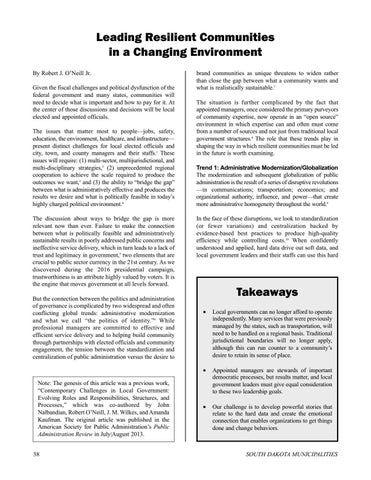Leading Resilient Communities in a Changing Environment By Robert J. O’Neill Jr. Given the fiscal challenges and political dysfunction of the federal government and many states, communities will need to decide what is important and how to pay for it. At the center of those discussions and decisions will be local elected and appointed officials. The issues that matter most to people—jobs, safety, education, the environment, healthcare, and infrastructure— present distinct challenges for local elected officials and city, town, and county managers and their staffs.1 These issues will require: (1) multi-sector, multijurisdictional, and multi-disciplinary strategies,2 (2) unprecedented regional cooperation to achieve the scale required to produce the outcomes we want,3 and (3) the ability to “bridge the gap” between what is administratively effective and produces the results we desire and what is politically feasible in today’s highly charged political environment.4 The discussion about ways to bridge the gap is more relevant now than ever. Failure to make the connection between what is politically feasible and administratively sustainable results in poorly addressed public concerns and ineffective service delivery, which in turn leads to a lack of trust and legitimacy in government,5 two elements that are crucial to public sector currency in the 21st century. As we discovered during the 2016 presidential campaign, trustworthiness is an attribute highly valued by voters. It is the engine that moves government at all levels forward. But the connection between the politics and administration of governance is complicated by two widespread and often conflicting global trends: administrative modernization and what we call “the politics of identity.”6 While professional managers are committed to effective and efficient service delivery and to helping build community through partnerships with elected officials and community engagement, the tension between the standardization and centralization of public administration versus the desire to
Note: The genesis of this article was a previous work, “Contemporary Challenges in Local Government: Evolving Roles and Responsibilities, Structures, and Processes,” which was co-authored by John Nalbandian, Robert O’Neill, J. M. Wilkes, and Amanda Kaufman. The original article was published in the American Society for Public Administration’s Public Administration Review in July|August 2013. 38
brand communities as unique threatens to widen rather than close the gap between what a community wants and what is realistically sustainable.7 The situation is further complicated by the fact that appointed managers, once considered the primary purveyors of community expertise, now operate in an “open source” environment in which expertise can and often must come from a number of sources and not just from traditional local government structures.8 The role that these trends play in shaping the way in which resilient communities must be led in the future is worth examining. Trend 1: Administrative Modernization/Globalization The modernization and subsequent globalization of public administration is the result of a series of disruptive revolutions —in communications; transportation; economics; and organizational authority, influence, and power—that create more administrative homogeneity throughout the world.9 In the face of these disruptions, we look to standardization (or fewer variations) and centralization backed by evidence-based best practices to produce high-quality efficiency while controlling costs.10 When confidently understood and applied, hard data drive out soft data, and local government leaders and their staffs can use this hard
Takeaways j
Local governments can no longer afford to operate independently. Many services that were previously managed by the states, such as transportation, will need to be handled on a regional basis. Traditional jurisdictional boundaries will no longer apply, although this can run counter to a community’s desire to retain its sense of place.
j
Appointed managers are stewards of important democratic processes, but results matter, and local government leaders must give equal consideration to these two leadership goals.
j
Our challenge is to develop powerful stories that relate to the hard data and create the emotional connection that enables organizations to get things done and change behaviors.
SOUTH DAKOTA MUNICIPALITIES















